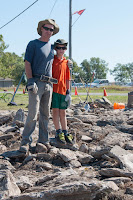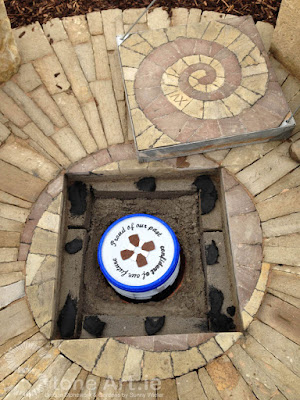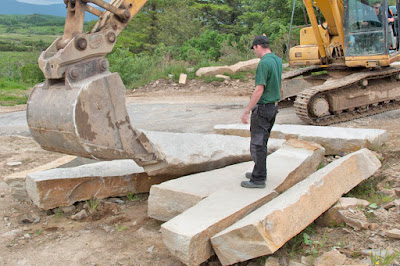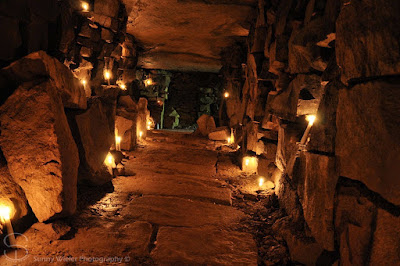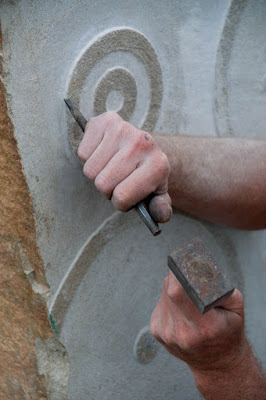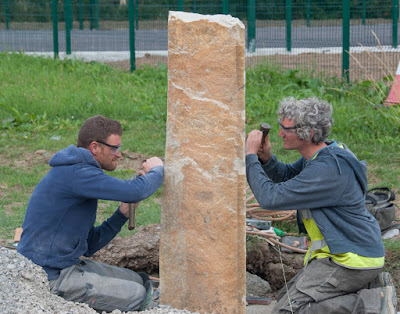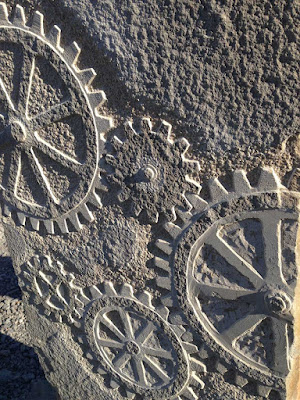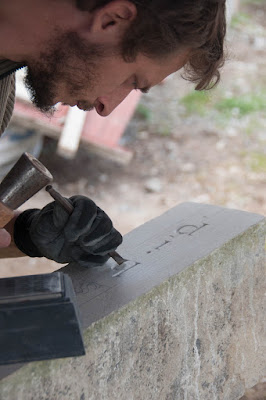![]() |
| Jumping for Joy. Andre Lemieux, John Bland, Sunny Wieler, Ken Curran, Dom Keogh, Doug Bell |
September was a busy month for stone festivals. First we returned to
'The Gathering of Stones' site to put the final arch in place and to make plans for the final push to completion of our dry stone monument. Then with little respite the clan regrouped on Inis Oirr Island for our annual trip out to
Féile na gCloch (Festival of Stone). But before I had time to absorb the fun had on Inis Oirr island, I had to rush home to repack my bag to catch my flight to another great stone festival on another great little island. This island however lies a little further west of Galway bay, a lot further west in fact.
![]()
Late last year Ken Curran and myself were invited by
Dry Stone Canada to come to Canada to be part of their annual dry stone festival as representatives of
The Dry Stone Wall Association of Ireland. They were keen to have the Irish dry stone wall association involved as their festival this year was to have a very Irish twist.
![]() |
| Historic dry stone walls on Amherst Island. Photo Ken Curran |
Their dry stone festival was to take place on Amherst Island. Situated 2.5 hours east of Toronto on Lake Ontario,
Amherst Island is an island with a strong Irish connection.
Right across the island, there are many old dry stone walls. Many of these walls date back to the 1800's when Irish settlers immigrated to the island. These Irish immigrants (many of whom came from
Ayrds Peninsula) are accredited with having built most of the dry stone walls that still remain on the island.
![]() |
| The town of Stella on Amherst Island Photo Ken Curran |
Travelling to the island on a short 20min ferry journey, we arrived in the township of Stella. Although very picturesque, there are very few facilities still open on the island. Even the general store has closed in recent years meaning everything has to come from the mainland.
![]() |
Some of the local heros.
Photo Vicki Keith |
With a population of about 450 people, there is not much in the way of accommodation on the island. This brought me to my first question. Where on earth are we all going to stay? Oh you are all being 'billeted' I was told.
Billeted is a term that I had not heard before so this quickly led to my next question. What is 'billeted'? A billet is a an old army term for living quarters to which a soldier is assigned to sleep. Historically, it referred to a private dwelling that was required to accept the soldier.
It was clear from the get go that the islanders were very much involved in the festival and their contributions/ hospitality and warmth are one of the things that made this festival so special.
Across the island the Irish Tricolour was flying proudly outside numerous properties. This pride and welcome would make any Irishman feel as if he were home.
The festival itself consisted of two dry stone builds, an Irish sampler wall for the students and a solar alignment feature for some of the professional wallers who came to the festival.
![]() |
| A section of the Irish sampler wall built by students during the festival. Photo Brian Little |
Under the instruction of master Irish stonemason Patrick McAfee and other master masons , the Irish sampler wall was to be built using the local limestone, most ofwhich was donated by the islanders.
The local limestone is very similar to the karst limestone of the Aran Islands back in Ireland so it was decided the the Irish sampler wall would be built in wall styles found on the Aran Islands.
![]() |
| Irish wall styles |
The two wall styles chosen were a single wedged wall and a Feidin wall. A single wedged wall is a wall where stones the full depth of the wall are laid vertically and as the name suggests, wedged together. The second wall type is a combination wall known as a Feidin wall. This wall consists of a double wall on the bottom with a single wall on top. This very unusual wall type is unique to Ireland and a small area of Scotland.
A Feidin wall is built by placing large upright stones known as 'Mother' stones at intervals along the foundation. Between the 'mother' stones a double sided wall is built using smaller stones known as 'children' stones. To finish off the wall a single wedged wall is built on top using larger stones known as 'father' stones.
This style of wall not only makes for a great story, but it is also an incredibly strong method of building.
During the course of the weekend over 100ft of wall was built.
![]() |
| Dan Pearl setting the 'father stones' |
![]()
Islander and festival facilitator Jacob Murray poses for a photo with his son. Sponsored by the islanders, Jacob attended our
Tír Ċonaill Stone Festival in Donegal last year to learn about running a festival back on Amherst.
Jacob is also one of just a few dry stone wallers remaining on Amherst island and is responsible for much of the lovely modern dry stone walls appearing across the island.
![]() |
| One of the carvings by Karin Sprague,the last initial of the land donor for the project, Dayle Gowan. Photo: Ken Curran |
![]() |
| John Crowe, early Island wall builder from the 1800's honoured, and a stone from Ards stone carved and sent by Ards Women's Institute in Northern Ireland. Photo Brian Little | | |
![]() |
| 'Remember Them' a quote from Jane Urquhart's book. Carved by Danny Barber of Smith & Barber. |
![]() |
| Vice President of Dry Stone Canada Eric Landman standing tall alongside President Andre Lemieux. |
![]() |
| Finished wall with a clapper bridge built by Norman Haddow. One end of this bridge had 1822 (the date of the first European settlers on the Island) carved on by Tracy Mahaffey the other end had 2015 by Karin Sprague |
While the grownups built walls
John Shaw-Rimmington was keeping the kids entertained with a dry spud walling event.
The spuds were a play on the Irish theme but were also a great fun and safe way for the young kids to learn some of the basic principles for dry stone construction.
On the last day of the festival the 2 tons of potatoes used were donated by Dry Stone Canada to Loving Spoonful in Kingston, supplying 26 Kingston groups including hot meal programs and homeless shelters.
![]() |
| Building arches or 'Starches' and John was calling them. |
What made this festival very special indeed was the professional feature built on the same site as the Irish sampler wall.
The design, dreamed up by Montreal dry stone waller
John Bland was to be an interactive structure that would also mark the close of the festival at 18:30 on the final day of the festival.
John also wanted to build something that would have an Irish theme. Here in Ireland the Celts have been marking important days on the calendar using beams of light for over 5000 years. The best example of this is
Newgrange where on the winter solstice a beam of light travels through a small window to illuminate a small stone chamber. (read more about Newgrange
here)
Unfazed by the massive challenge of attempting to build such a complex structure, John decided to follow the way of the Celts and design a dry stone structure that would, on the close of the festival, send a beam of light through an opening in a Celtic cross wall, and project the light onto a carving at the far end of the structure.
Four pillars with cantilevered seats are also perfectly lined up with the angle of the sun to create one solid shadow at the precise moment the light hits the carving.
"I spent many months working on the design and a
lot of time pacing around my house trying to think
of what I could be missing. There are a lot of site
requirements and a lot of moving parts in attempting
a project like this. The site had to be perfect in
terms of having a line of sight to the setting
sun...and it was: the lower the angle the better, in
order to cast longer shadows. The sun also seems to
have less intensity which can provide a light effect
that is softer and more colorful to look at during
events. At the same time the sunlight had to be
strong enough to be able to cast a beam of light that
was highly visible on the Claddagh stone. We didn't
necessarily need level terrain but it was nice and
level which made things a lot easier. Layout was a
challenge...many string lines, many batter frames, all
of it had to be very precise. The team of guys that
worked on the project in my mind are all superstars,
the kind of guys that show up on day one not
knowing what to expect and after a minute of
walking around the work site just get it and know
what to do. It was a great collaboration from all the
dry stone wallers as well as people of Amherst
Island to make it a success!"
![]()
The animated GIF above shows how the beam of light moves across the structure
![]() |
| The Celtic cross sun portal. Photo by Vicki Keith |
![]() |
| The relief carving carved on site by Tracy Mahaffey is of a Claddagh ring. The Claddagh ring is a traditional Irish ring which represents love, loyalty, and friendship. |
After coming up with the concept John spent the next six months working out the design and calculating all the precision angles and measurements needed for the structure to work.
Then long before any of us arrived on the island to begin work, John was already on site for two weeks setting out batter frames on string lines, anxiously checking and re-checking measurements. He knew from his computer mock up that the design should work but unfortunately for him he wouldn't find out for sure until the structure was built with the eyes of hundreds of people watching in anticipation to see if it would work in real life.
The first day on site everything was laid out and ready to go. So wallers from across North America (and a few Celts) got to work on building up the walls.
The majority of the stone for the solar project was built using
Mocha Limestone donated by Upper Canada Stone. It was decided to use the local island karst limestone for the features, namely, the small moongate (sun portal) and the cantilevered seats. The Celtic cross sun portal was left to the Irish lads to build. (Sunny Wieler, Ken Curran) In contrast to the Mocha Limestone supplied by Upper Canada Stone, the portal was built using the local Karst Limestone. It was built to a precise angle in line with the angle of the sun so that it would project a beam of light on the carving on the other end of the structure at precisely 18:30 on the Sunday (the closing of the festival).
![]() |
| Four pillars with cantilevered slabs of local stone create seating for the solar spectators. |
![]() |
| Jared Flynn and Mike Murphy from The Stone Trust Vermont work on the Celtic cross feature wall. |
Building the Celtic cross moongate or sun portal as I call it (seems more appropriate) using the local karst limestone was quite challenging as it was almost impossible to shape.
By sundown on the Saturday it was apparent there was still much to do on the feature. However with many great wallers at hand we made good progress.
![]() |
| Some of the wallers who worked on the professional feature. Photo Brian Little |
The weather was amazing all weekend, with unbroken sunshine. On the Sunday as we rushed to get the Celtic cross wall completed in time, clouds began to creep up over the horizon. Looking over at John's face I could see him trying to stare down the clouds. He quickly went from worrying about having the hole in a wall ready for the sun to shine through, to worrying about having a sun to shine through a hole in a wall.
As we neared 18:30 (the moment of truth) the crowds grew bigger, as did the wall, as did the clouds.
With just minutes to spare, the wall was finished and the scaffolding whisked away. As the clock hit 18:30 we all felt proud in what we had achieved but were also quietly disappointed in the failure of the sun to show up for the show.
It was at this point that John got up and began to demonstrate to the audience what should be happening were the sun not hiding.
As John walked around the site making frustrated hand gestures of sunbeams, there was a glimmer of hope on the horizon........ encouraged by the golden glow of the vaporous mass hiding the sun, master mason/musician
Bobby Watt began to sing '
Here comes the sun' Then as if scripted all along, just as everyone joined Bobby in song, an explosion of light blasted through the cross lighting up the craving.
![]() |
| The sun at 18:34 precisely where it should be having just past over the carving. |
With the excited cries from John Bland shouting 'ITS WORKING, ITS WORKING' the spectators threw caution to the wind and bolted straight through the barriers and stormed the structure with excitement.
What an amazing end to a wonderful festival. Never before have I experienced an end to a festival like this, and how could it possibly be topped.
Who could ever have imagined dry stone walls and their builders having such an impact on a community? A true celebration of a craft at its utmost and a credit to all the truly great wallers that live and work in Canada.
Following the end of the festival, those who remained on the island returned to
The Lodge for one last glorious meal. Then as if planned all along, there just happened to be a blood moon, lunar eclipse happening the same day as well.
So with our bellies full of food and a brew in our hands, we returned to the structure in the cover of darkness.
Perched on cantilevered seats of Amherst stone, our gaze returned to the skies once more to watch the lunar special unfold.
The festival was deemed by all to be a huge success.
The attendance over the 3 day festival was estimated to be about 1,200 and was attended by a number of distinguished guests including the Irish Ambassador to Canada, His Excellency Dr. Ray Bassett and his wife, Patricia Bassett, the Honourable Michael Coteau, Minister of Tourism, Sport and Culture for Ontario, Deputy Mayor of Loyalist Township, Ric Bresee and celebrated author, Jane Urquhart.
An appearance was also made by Canadian comedian and television personality Rick Mercer who filmed a segment for his show The Rick Mercer Report. You can view the clip below.
Both Dry Stone Canada and The Dry Stone Wall Association of Ireland even got a mention in the Ontario parliament. See video clip below
Right throughout the weekend there was a great scene of festivities, boosted by the Harvest Festival which was also happening over the weekend. Many Irish acts rotated between the dry stone festival site and the Emerald Music Festival site at the harvest festival to make sure that no one on the island was ever more than a few meters away from a fiddle and any time.
Local brewery
Mackinnon brothers from just across the water on the mainland in Kingston made sure all the wallers were well lubricated for the weekend by sponsoring plenty of beer for the weekend.
Fellow Irishman (and mighty musician) Dom Keogh who came over especially to take part in the festival summed it up so well that I am going to post his parting reflections on the Monday after the festival, just after he left having helped us tidy up the site in the pouring rain.
“And so it ends. Even though it lashed out of the
heavens today, and the copes were tough to find, it
was still very hard to leave the site and the island
today! What an amazing weekend. I knew no one
going out there, and I've come back with a load of
new friends and had a hand in creating a magnificent
structure for Amherst Island. Yesterday was just
one of those brilliant days. We got the cross and
wall finished with pure single minded determination,
then just before the sun was ready to align with the
chamber in the cross for 6.30pm, as John Bland had
expertly set out, there was cloud cover!!! We were
all feeling that it might not happen, then Robert Watt
sang "here comes the sun", and the clouds parted
and the beam of sunlight poured through the
chamber to illuminate this carving, and John's very
very proud head! Everyone felt how special the
moment was, especially those of us who had a hand
in building it. Then to top it off, we all returned to
the site that night to watch the lunar eclipse, sitting
on the benches and among the walls we had all
worked on. I can't thank Andre Lemieux enough for
everything he did for me, I couldn't put my hand out
for a second before a hammer, a plate of food, or a
beer was put into it!! And the rest of the lads -
Kenny Davies, Menno Braam, Torben Larsen, Jacob
Murray - to mention a tiny few for making me feel
so welcome and giving me a pain in me sides
laughing. I know I'll end up saying "limestone is
like a mushroom" to someone at home and they'll
think I've lost the plot! And a special thanks to
Sunny Wieler and Ken Curran for the craic, and
doing us proud as ambassadors for the Dry stone
wallers of Ireland. I thought music festivals were
hardcore, not a bloody patch on a Stone fest!!!
Same amount of drinking, but then ur up at 7am
building all day!! :)) I'm fried, inside and out! :))”
A local island brewer even made a special brew just for the festival called 'Dry Stone Ale'
Thanks so much to everyone who made this weekend happen. A special thanks to Dry Stone Canada for inviting me over for the festival. A massive thank you also to Andrea Cross, who was the driving force behind this festival and without her none of this would have been possible. Thank you to the landowner Dayle Gowan who donated the use of his land, for without land to build on we would not have had a feature to leave behind. Thank you also to the Redekops who billeted Ken and myself and made us feel so welcome in their home.
If you want to keep uptodate with all things dry stone in Ireland be sure to check out Dry Stone Wall Association of Ireland website
http://www.dswai.ie/![]() |
| Jacob Murray Island liaison, John Bland designer of the solar alignment, Dayle Gowan, donator of the land, and Andrea Cross, organizer extraordinaire, celebrating the festival's success. Photo Brian Little |
Thanks also to Brian Little for the use of some of his photos for this post. Be sure to check out his work
http://www.brianlittlephoto.com/ You can see all the photos I took over the weekend in the album below.
![Dry Stone Festival Amherst Island 2015]()
After returning home it was wonderful to hear that the sun portal structure has become a regular gathering place for locals to gather to have a glass of wine and watch the sun go down.
![]() |
| The section of wall completed by the Islanders after the festival. Photo Brian Little |
It was great to hear that the promotion of the craft on the island also resulted in locals putting their newly acquired skills work and adding a extra section of wall to the Irish sampler wall
![]() |
| Historic wall repair on the island after the festival. Photo Brian Little |
This was followed by an additional dry stone walling workshop that saw one of the island's historic walls repaired.
Stone carvers Tracy Mahaffey and Karin Sprague returned to the Island to give a stone carving workshop.
So the island's historic dry stone walls look to be in safe hands and are set to continue to have a future on the island. Back at home I have been busy harnessing the sun in a different way for one of my own projects, but that is a story for another day.

























































































































.jpg)
.jpg)

.jpg)
.jpg)
























 The work I have shown here is just a taste of the amazing work that Andrew has completed to date. To see his complete works, check out his website
The work I have shown here is just a taste of the amazing work that Andrew has completed to date. To see his complete works, check out his website 























































.jpg)



























